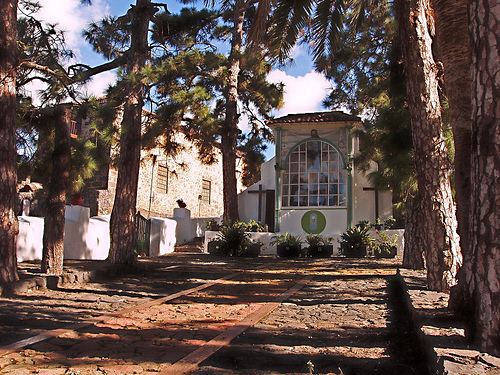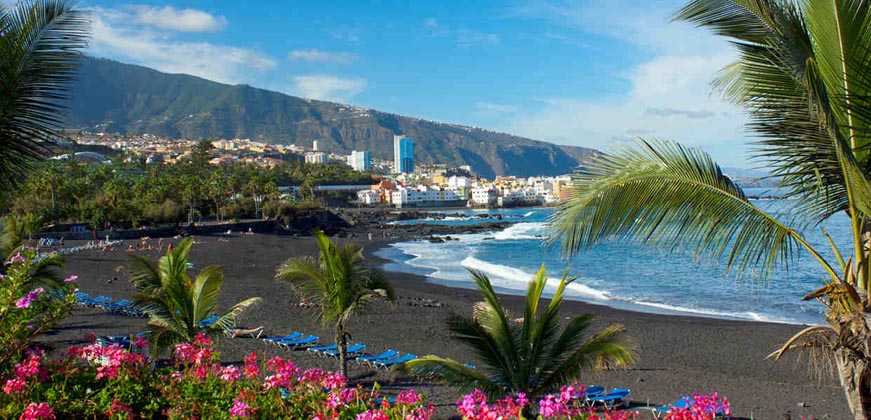Puerto de la Cruz in the north of Tenerife is a holiday resort, the sunny point of the northern part of the island (apparently even if it rains in the north, the sun is shining in Puerto de la Cruz). It is not as warm and sunny here as in the south, and yet in years 60. In the 20th century, it was from Puerto de la Cruz that mass tourism began. Consequently, there are many hotels in the town, a few tall skyscrapers and lots of bars, restaurants and gift shops, which attract somewhat quieter tourists than the southern resorts. On the other hand, the oldest part of Puerto de la Cruz has managed to maintain the true Canarian climate and charm of a small town, where they live, residents also work and play.
This is unusual for a resort, but in Puerto de la Cruz there is a lot to see. The central point of the old part of the city is Plaza del Charco (puddle – pool), flooded many times during storms in the past. A square planted with Indian laurels, around which there are old tenement houses and modern buildings, is one of the best places for coffee or lunch. Picturesque Quintana Street leads to San Francisco Church, closely adjacent to the small Ermita de San Juan. Inconspicuous chapel, built in 1559 r., it is the oldest building in the city. Two blocks away is the mythical square with the city's main church, XVII-wiecznym Our Lady of the Rock of France. Inside the three-nave temple, you can admire a Mudejar-style wooden vault and a beautiful Baroque altar. The greatest treasures of the temple are a silver-plated cross - the symbol of the city and a statue of the Virgin Mary, which is the most important figure in the celebrated Virgen del Carmen fiesta.
From Plaza del Charco you can go to the former fishing port – the sculpture of a fish trader reminds us of its original function. There is a beautifully restored customs house in the port – Customs House, which houses the tourist information office, a handicraft shop and a gallery of the Center for Spanish Studies, where exhibitions of contemporary Spanish art are held. Building with 1620 r. is an excellent example of Canarian architecture, with beautiful wooden balconies and palm trees. Continue on calle de la Lonja, passes by one of the most beautiful eighteenth-century city mansions, Miranda's House, and comes to the spacious Europa Beach, from where you can admire the panorama of the city. An equally nice view is from Punta del Viento, a few hundred meters away, where the seaside promenade of San Telmo begins, ending with a white chapel visible from a distance 1780 r. The chapel marks the end of the historic part of Santa Cruz de Tenerife – behind it there is a wide seaside promenade and high ones, modern hotel and residential buildings.
To the west of Plaza del Charco stands the seat of the Museo Arqueológico (Archeological museum), where you can learn a little more about the customs of Guanches. Utility items have been collected in the facility, including urns, and the cave was reconstructed, in which the original inhabitants of Tenerife probably lived. A bit further, The 17th-century Castillo de San Felipe rises next to the Jardmes beach.
Parrot park
The largest nature park on the islands is just as amazing, what and criticism, especially from animal rights activists and opponents of mass tourism. Regardless of criticism 165 thousand. m 2 guarantees great fun for the whole family. Outside over 350 many species of exotic animals live here with species of parrots from all over the world – from white tigers and gorillas, through the penguins, right up to the sharks, which is observed while walking through the glazed tunnel. Willing people can go to shows with the participation of seals, dolphins and killer whales. From a special stop in front of Lago M'artinez co 20 there is a free cable car to Loro Parque. Tourists from southern resorts can take advantage of special free buses, departing from Playa Americas and Los Cristianos.
Jardin Botanico
Founded by the Spanish King Charles III in 1788 r. the garden is Puerto del Carmen's oldest attraction. Originally, it was to serve as an acclimatization garden for plants transported from exotic countries to Spain (hence the name-Jardin de Aclimatación). On 2500 m2 grows here over 200 plant and tree species.
Banana El Guanche
Miniature banana plantation and botanical garden, 3 km east of Puerto de la Cruz, this place, where you can learn a lot about the most famous fruit of the archipelago. The visit to the plantation ends with tasting bananas and the liqueur made from them. Free bus every 30 min runs between the plantation and Puerto de la Cruz (hotel Atlantis).
Small town
To visit all the islands of the archipelago in one afternoon, Pueblo Chico is enough, where on air recreated to scale 1:25 the most characteristic buildings and landscapes of the Canary Islands. Free buses run to Pueblo Chico from Puerto de la Cruz.
Valley Oasis
Camel rides are also organized in the petting zoo and botanical garden. There is a restaurant in the Oasis del Valle area serving "typical Canarian food" (at this point, however, it is better not to try it).
Beaches
Unfortunately, Puerto de la Cruz cannot boast of gold, sandy beaches. Two black beaches await amateurs of sun and sea bathing – kilometer long Playa de Jardin at the western end of the city, surrounded by beautiful gardens designed by Cesar Manriąue and Playa de Martianez at the eastern end. One of the biggest beach and bathing attractions is Lago Martianez by Manrique. The three-hectare seafront complex consists of four pools filled with seawater (at the center of the largest of them is an island), sunbathing areas and green oases with palm trees. As befits the work of an artist from Lanzarote, the whole thing is very aesthetic and friendly to both people, and the environment.

